I’ll fish any fly. Really, I’ll fish anything. I have zero hang ups about synthetic materials or fluorescent colors. I don’t care if the fly is fur and feathers or nylon and silicone. If a plastic minnow caught more trout than a Pheasant Tail nymph, I’d fish it. But the Pheasant Tail is better. Trust me. I’ve fished a lot of nymphs and too many plastic minnows.
The experienced anglers that I know all end up with a small group of patterns that are personal to them, with maybe a touch of antron mixed into the dubbing or a few wraps of orange thread to lend the fly a little character — to boost its fish catching mojo.
I have my own handful of confidence flies, the ones I rely on day in and day out. But after all these years, I’ve caught enough trout that my goals are different. I’m not trying to catch all the fish on all the days anymore. More often, I’m just trying to learn something new out there. So I’ll swap out a killer fly simply to see what else doesn’t work. There’s some measure of rebelliousness to that, I guess. It’s like staring down the fish and saying, “I don’t give a shit. I’ll screw this whole thing up on purpose.”And I like to do it when the fish are really turned on. Yeah, I’ll sabotage a good thing with a bad fly, just to see what happens.
I have a lot of thoughts about why trout eat things. Yeah, I’m open minded (perhaps to a fault), but I also know what works on the water, and I usually have a theory about why they do. It’s all based on lots of fishing and years of trying to experimentally screw things up.
So when I say this I mean it. Beads are the best. My nymphs with beads routinely outfish nymphs without beads. There are some exceptions, of course, and I’m happy to have many beadless patterns in my box that I count on to fool fish: flies like a WD40, RS2, a Green Weenie and others. I bead most everything else. Sure, I have a lot of soft hackle wets and such, and most of my egg patterns have no bead either. But the mainstay of my nymph box, the sections that I keep replenishing, because fish or tree branches take them and don’t give them back, are beaded flies.
I have lots of stories to tell about slow times without the beadhead, moments and days that were turned around by switching to nymphs with that muscled, beefed up and brighter look of a bead at the head of a fly.
The fact is, my handful of confidence flies has a lot of beads in it. They’re my best year-round patterns, simple flies like Walt’s Worms, Hare’s Ears, Pheasant Tails and Girdle Bugs. They all have minor variations of dubbing, ribbing or collars, and they all have beads. At one time or another, I’ve tied and fished all of them without beadheads, just to see what happens. And I’ll tell you what happens — not as much fish catching.
It’s not a weight thing. Common wisdom says that beadhead nymphs work because they get to the bottom. Nonsense. I get all my nymphs to the bottom with split shot, beads or lead wraps on the hook shank. For tungsten or brass beads, combined with lead wraps or not, I’m convinced that the the added weight of the bead is not the reason for a beadhead nymph’s success. So why do they catch more fish?
Another popular theory suggests that beads look like an air bubble. I first read about caddis and their use of an air bubble during emergence in Gary LaFontaine’s excellent and comprehensive work, “Caddisflies.” Undoubtedly, trout key on caddis and their air bubbles during a hatch. It’s something the fish are looking for, and a bead just might resemble that bubble. I can buy that. But what about all the other patterns that fish better when beaded? What about the stoneflies, the mayflies, the midges and even the junk flies that I fish with a bead? What about those times when no caddis are emerging? Beadhead patterns produce best for me all year long. So why do they catch more fish?
Perhaps we should consider that beads are attractors, nothing more and nothing less. Remember that plastic minnow? Remember the Rooster Tail? The Mepps Spinner? Trout love a bit of flash, and sometimes a beadhead shows them precisely the right amount. It can be the tiny silver bead on a Zebra Midge, but it still makes all the difference.
On many flies, the beadhead becomes the defining characteristic. Oftentimes, when trout are taking a #14 nymph with a gold bead and a tapered body, the color and composition of that body hardly matters — the gold bead is what matters. All the other things we build into the fly don’t mean much — it’s the bead.
I’ve long believed that trout are looking for reasons not to take a fly, that adding extra materials just gives them more to reject. So my most successful patterns are simple, and usually, that starts with a bead. A copper, gold, silver or black nickel bead is at the head of my best patterns.





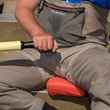

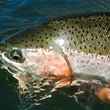




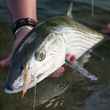



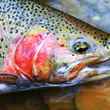



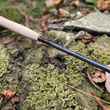
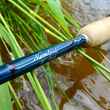







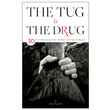
Comments
Mountain man replied on Permalink
This leads me to ask......Have you ever fished with just a bead on a hook?
Jim k replied on Permalink
Stock trout like flash on fly..Rainbows like silver and browns gold....
Bead is bad for fly it causes it to act not normal..
But stock trout do not care....
So if you have trout that are wild or pressured go without bead or take marker like a black or brown and paint the bead dark ...
Bead causes fly to nosedive but stocked trout seem to not care ..
Put on a weightless nymph for wild trout and you wild catch many more ....move normal and no flash...
jeff replied on Permalink
Mountain man, Considering that a black or red hook is a pretty damn good midge larva imitation, I see no reason that adding a bead to it would make it worse, assuming Dom is correct.
Brue replied on Permalink
Well, Domenick, it must come down to what you believe personally. There are times my trout will take an un-beaded PT, Walt's Worm, Hares Ear, etc., especially during low water. I have a buddy who says you don't even need to dress a hook with a bead on it and fish will eat it. You get it--no dressing equals no fly, therefore, it is a lure. In my experience I can't find a rhyme or reason why trout choose to eat what they eat on a particular day. But, like always I get what you're saying.
Feather Chucker replied on Permalink
I've always felt they take them out of curiosity. Trout can only test things with their mouth.
Paul replied on Permalink
HMMM? You have shattered a myth for me. I was ALWAYS under the assumption that beads get the tiny fly down quicker and in the strike zone in a more natural fashion. A person learns something new every day if they pay attention. Question: If a black bead provides just the correct amount of the "flash" needed couldn't the tyer just add black glossy thread and accomplish the same results? Did you try that experiment? Curiosity has the best of me here.
Brue replied on Permalink
Hi Paul, I'm no expert, but I feel flashy gold beads in skinny water tend to put trout off. Also, and this is just my way of thinking, there is really nothing natural about gold beads, but I do feel they are needed in faster, deeper water to get my flies into the zone. I also weight my flies with lead wire so the weight is unobtrusive to the fish. I feel it makes a difference in certain situations. These are just my methods and they could be entirely wrong. I always enjoy exchanging ideas and philosophies.
Mark Haven replied on Permalink
Hmm, I've fished for twenty years and have had the exact opposite experience. I always fish a beaded pattern with a natural pattern trailing and almost never get a hit on the beaded pattern. Could be a location thing. I really do feel like different geographies and streams can fish really differently. That's why we have guides.
jeff replied on Permalink
Do you think that in some heavily pressured waters where fish have been caught several times, that beads can start to have the opposite effect? i.e. trout starting to get scared of them.
Marc Barnwell replied on Permalink
My guiding experience would definitely agree with half of that! I agree it’s a flash thing but the other half of the equation is weight… You have to get your fly down to where the fish is…Period!
So abandon those old school brass bead nymphs (obviously keep them depending on the depth you’re fishing) and go up a size in those tungsten beads for greatly improvement fish hookups!
Pages